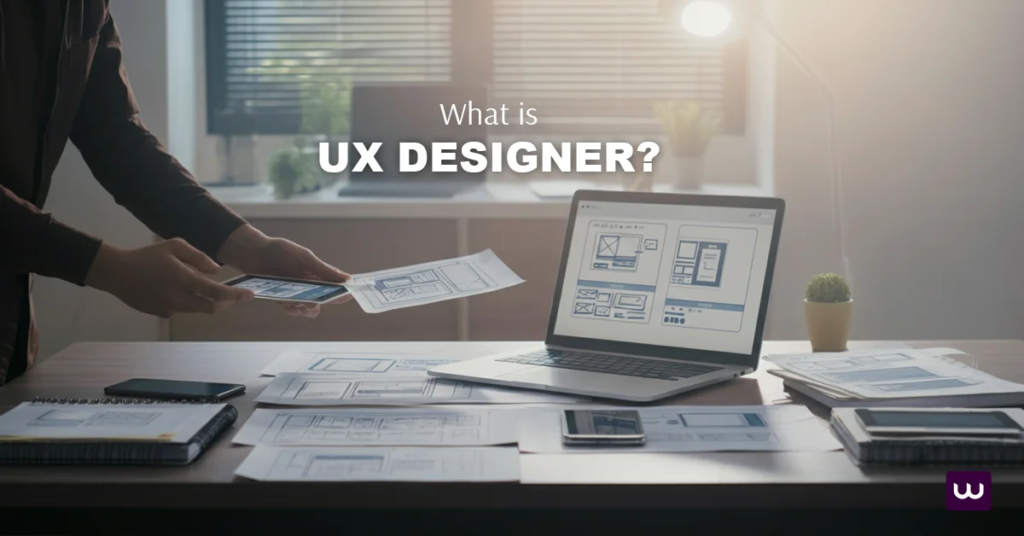
What is UX Designer? A UX designer, or User Experience designer, is a professional dedicated to ensuring a product is both easy to use and effectively meets the needs of its users. This involves a comprehensive process of understanding user needs and then designing solutions that are straightforward and user-friendly. Essentially, a UX designer’s role encompasses conducting thorough user research, creating initial design blueprints known as wireframes, and rigorously testing prototypes, all with the goal of crafting valuable and positive user experiences.
Key Takeaways
UX designers focus on creating enjoyable and accessible experiences for users, impacting product success across various industries.
The UX design process is iterative and user-centered, involving research, prototyping, and usability testing to refine solutions.
A career in UX design offers diverse opportunities and the potential for growth, with a strong emphasis on continuous learning and networking.
Understanding the Role of a UX Designer

UX design is fundamentally about addressing every facet of the end-user’s interaction with a company and its offerings. A UX designer’s responsibilities are multifaceted, encompassing the development of products and services that are not only easy to use, but also pleasant and universally accessible.
This involves utilizing essential design tools and conducting thorough user research to gain a deep understanding of user needs and behaviors. At the core of a UX designer’s role is the creation of products and services that are both functional and enjoyable. This requires an intricate comprehension of what users require, how they behave, and the challenges or “pain points” they encounter.
This knowledge is crucial for shaping experiences that excel in both function and enjoyment, ensuring that the product or service effectively serves its purpose while also providing a positive and satisfying user experience. Ultimately, UX designers aim to forge significant interactions that resonate positively with users, ensuring each point of contact with the product is smooth and fulfilling.
Their influence extends across various domains, from enhancing the user experience of software applications to optimizing the layout of physical spaces, such as supermarkets. These efforts play a pivotal role in determining whether a product thrives or falters in the marketplace.
Key Responsibilities of a UX Designer
UX designers are versatile professionals with a wide range of responsibilities. A foundational element of their work is conducting user research to identify user needs, goals, and pain points. This research informs the entire design process, ensuring that the final solutions are truly user-centric and address the specific needs of the target audience.
Following the research phase, UX designers develop wireframes and prototypes. These tools are essential for visualizing the final product and exploring different design solutions efficiently. They also facilitate iterative design, allowing designers to refine their ideas based on user feedback and testing. Typical responsibilities of a UX designer include ideation, prototyping, testing, creating user personas to represent different user types, and mapping user journeys to understand the user’s experience across different touchpoints.
Wireframing plays a crucial role in the design process. It allows UX designers to draft the basic structure of a product without focusing on visual details. This enables them to concentrate on refining ideas, ensuring the product’s functionality aligns with user expectations and provides a clear and intuitive user experience.
Essential UX Design Skills
A successful UX designer requires a diverse skill set, encompassing both the technical expertise and interpersonal abilities crucial to their craft. Core competencies in UX design, such as conducting user research, crafting effective interaction designs, and carrying out thorough usability testing, are fundamental.
The technical abilities necessary for these tasks include strong analytical reasoning, adeptness with interactive elements within design frameworks, and mastery over various design software. These hard skills form the foundation upon which effective UX design is built. While technical proficiency is essential, graphic design skills can significantly complement UX design. By enhancing the visual elements of a product, such as typography and color theory, graphic design contributes to a more engaging and aesthetically pleasing user experience.
These visual aspects play a pivotal role in eliciting specific user reactions and shaping their overall perception of the product. However, technical skills and graphic design knowledge are not enough. Soft skills hold equal importance in the realm of UX design. Effective communication talents, adaptability to changing scenarios or requirements, and the capacity for empathy are all critical traits for a successful UX designer.
User research is not simply about gathering data; it involves delving into the psychology of users to comprehend what drives them, what their motivations are, and what their pain points are. This deep understanding informs impactful design choices that truly resonate with the target audience. Teamwork plays a pivotal role in executing high-quality UX designs. Collaboration between designers themselves, along with developers and stakeholders, is essential.
This collaborative approach paves the way toward creating solutions that aren’t just technically sound and functional, but also visually compelling and aligned with business goals. A strong team dynamic fosters creativity, ensures that all perspectives are considered, and ultimately leads to a better end product.
The Importance of User Research
User research is absolutely crucial for effective UX design. It serves as the foundation upon which designers build their understanding of user needs, behaviors, and motivations. By employing a variety of research methods, such as direct observations, surveys, and ethnographic studies, designers can gather valuable insights that ensure the final solutions are truly user-centric and address real-world needs.
A key tool in user research is the development of user personas. These personas are representative archetypes that encapsulate the goals, emotions, pain points, and behaviors of different user groups. They provide a clear and concise picture of the target users, helping designers to empathize with them and understand their specific requirements.
By focusing on these personas, designers can tailor their designs to meet the needs of their intended audience effectively. Ultimately, this user-centered approach, driven by thorough research and informed by user personas, ensures that the final product resonates with real users.
It guarantees that the design not only looks good and functions well but also genuinely addresses the specific requirements and challenges faced by the people who will be using it. This leads to a more successful and impactful product that meets its objectives and satisfies its users.
The UX Design Process
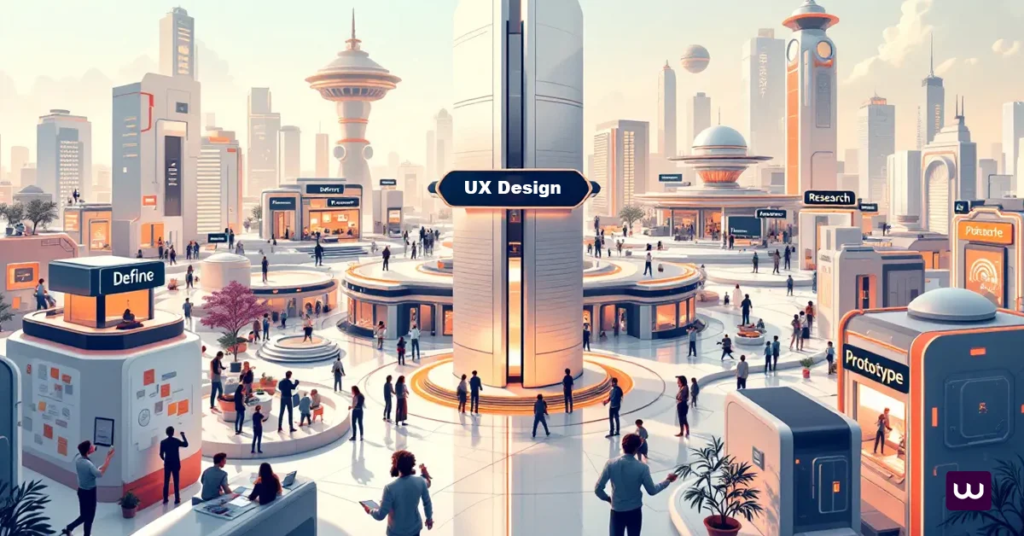
UX designers adhere to a meticulous design process, carefully tailored to guide them from initially pinpointing user issues to ultimately devising user-centered solutions. This process is characterized by distinct stages, encompassing everything from initial problem definition and thorough research to in-depth analysis of gathered data. It then moves through the visual and interface design phases, followed by prototyping, user testing, and finally, launching the product into the market.
Critically, the process also includes iterative improvement, recognizing that user needs and feedback are ongoing and require continuous refinement. This framework facilitates constant input and fine-tuning, ensuring that the final product aligns closely with evolving user expectations.
Within their workflow, UX designers utilize an array of specialized tools designed specifically for various stages of the design process. These tools are essential for crafting interactive prototypes, which allow users to experience the product before it’s fully built. They are also crucial for developing wireframes, which serve as the skeletal structure of the design, outlining the layout and functionality of each screen.
Furthermore, these tools assist in creating visually appealing and interactive elements that enhance the user experience. These instruments are critical in materializing abstract concepts and rigorously assessing their practicality and usability before proceeding with extensive and often costly development efforts.
The prototyping phase is particularly important as it allows designers to simulate the user experience and gather valuable feedback early in the process. By testing prototypes with real users, designers can identify potential usability issues, uncover areas of confusion, and gain insights into user preferences.
This iterative testing and refinement process ensures that the final product is not only functional but also intuitive and enjoyable to use. It minimizes the risk of launching a product that misses the mark with its target audience and reduces the need for costly redesigns later on.
Grasping the intricacies of the UX design process stands as a fundamental component for those aspiring to master this dynamic and increasingly important domain. Understanding the stages involved, the tools utilized, and the importance of user feedback provides a solid foundation for success. This knowledge lays out an effective blueprint for delivering digital products that not only meet business objectives but, more importantly, resonate positively with end-users, creating a satisfying and valuable experience.
Stages of the UX Design Process
The UX design process is comprised of several crucial phases, all working together to create a user-centered product. It begins with a foundational stage of user research and testing, where designers identify a specific problem or opportunity and delve into understanding user needs, objectives, behaviors, and the challenges they encounter.
This initial research phase provides valuable insights that inform subsequent design decisions and leads to brainstorming sessions and the delineation of user flows, mapping out the steps a user takes to interact with the product. Following the research and planning stages, designers move into the prototyping phase.
Here, they construct preliminary models or mock-ups of the product. These prototypes, which can range from low-fidelity sketches to high-fidelity interactive simulations, serve as invaluable tools for gathering feedback from users and evaluating both the usability and overall appeal of the design. This allows designers to test different approaches and refine their ideas before investing significant time and resources in full development.
The testing phase then brings forth usability examinations, specifically designed to uncover any problems or areas of friction present in the prototype. By observing users interacting with the prototype, designers can identify pain points, areas of confusion, and opportunities for improvement. This user feedback is then used to iterate on the designs, making necessary adjustments and enhancements to create a more seamless and intuitive user experience.
This entire methodology is characterized by its iterative nature. The design process is not linear but rather a cycle of research, prototyping, testing, and refinement. This iterative approach facilitates perpetual enhancements, allowing designers to continuously improve the product based on user feedback and testing until the final version is fully polished, user-friendly, and ready for release. This commitment to iterative design ensures that the final product meets the needs of its users and provides a positive and satisfying experience.
Design Thinking in UX
The design thinking methodology, with its core emphasis on empathy and iterative improvement, aligns seamlessly with the principles of UX design. This human-centered approach within the design thinking process is essential for UX designers because it encourages them to fully grasp users’ viewpoints, needs, and motivations.
By deeply understanding the user perspective, designers can ensure that the solutions they create are authentically focused on the user and effectively tackle legitimate issues, rather than simply addressing surface-level symptoms. A key characteristic of the design thinking process is its non-linear nature. This flexibility allows UX designers the freedom to cycle back to prior stages whenever necessary.
If new information emerges during testing, or if a particular design direction proves unfruitful, designers can revisit earlier phases, such as ideation or prototyping, to refine their approach. This iterative and adaptable strategy is crucial for creating truly effective solutions, as it allows for continuous learning and improvement throughout the design process.
The infusion of empathy throughout the design thinking process significantly strengthens UX designers’ capacity to resolve problems effectively. By putting themselves in the users’ shoes, designers can gain a deeper understanding of the challenges users face and the context in which they interact with the product. This empathetic approach informs design decisions and helps to ensure that the final product is not only functional but also intuitive and enjoyable to use.
Ultimately, the combination of design thinking and UX design principles fosters an environment where innovation thrives. The iterative and adaptable strategy inherent in design thinking, coupled with the user-centric focus of UX design, is vital in forging not only efficient but also inventive solutions in user experience designs. This approach allows designers to explore a wide range of possibilities, test different ideas, and ultimately create products that truly meet the needs of their users and provide a positive and meaningful experience.
Creating User Personas
Creating user personas is an absolutely essential step in the UX design process. These personas are not simply fictional characters; they are carefully constructed representations of different segments of the user base, developed using insights gathered through thorough user research. By representing diverse user groups, these personas allow UX designers to step outside of their own assumptions and biases and tailor their designs to meet the specific needs and expectations of a broader audience. This ensures that the final product resonates with its intended users and effectively addresses their unique requirements.
The creation of user personas typically occurs during the analysis and planning phases of the UX design process. Designers meticulously analyze the data collected during user research, looking for patterns and commonalities in user behaviors, motivations, goals, and pain points. This data is then synthesized into representative personas, each embodying the characteristics of a specific user group.
In addition to demographic information, these personas incorporate details about user motivations, behaviors, technical proficiency, and frustrations. User stories, which describe specific scenarios and tasks that users might undertake, are often developed alongside personas to further illustrate how different user types might interact with the product.
These well-defined user personas then serve as a guiding light for all subsequent design decisions. By keeping these representative users at the forefront of their minds, designers can ensure that every design choice, from information architecture to interface design, is aligned with the needs and preferences of the target audience.
This user-centered design approach, driven by the insights provided by user personas, significantly increases the likelihood of creating successful products that are not only functional and usable but also enjoyable and engaging for the people who will ultimately use them.
Tools and Techniques Used by UX Designers
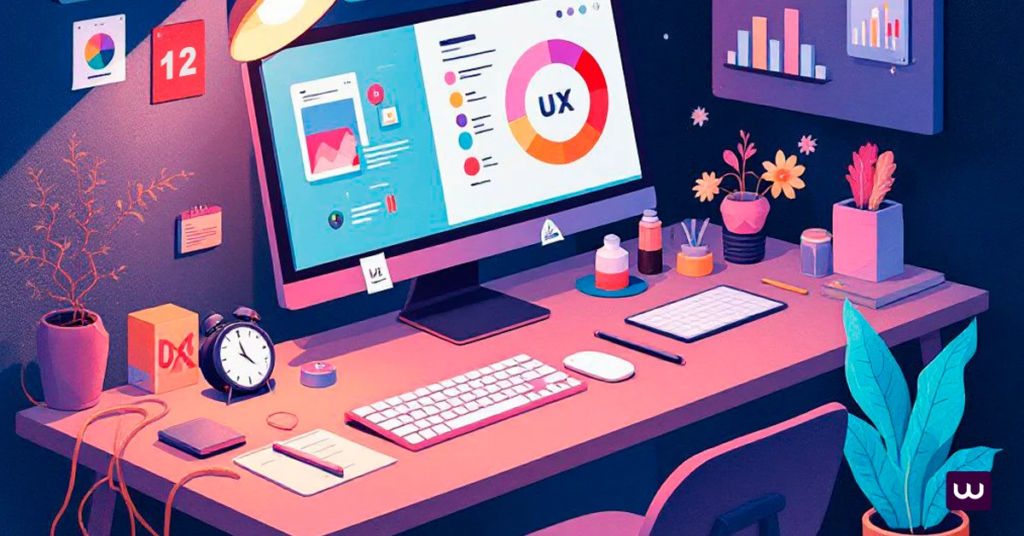
UX designers utilize a diverse array of methods and instruments to materialize their creative concepts. Renowned tools in UX design such as Sketch, Adobe XD, Figma, and InVision play a significant role in crafting interactive designs. These applications assist designers in optimizing their work processes, creating user flows, and improving teamwork through the use of collaborative projects.
Key steps like prototyping and wireframing are indispensable for conceptual visualization and assessing practicality. Wireframes offer basic visual outlines, while prototypes mimic actual user experiences. Usability tests are essential for collecting user feedback that is used to polish designs so they better fulfill user requirements.
Popular UX Design Tools
Figma is highly regarded for offering complimentary usage and capabilities that enable real-time teamwork, rendering it ideal for group projects. This platform empowers various designers to collaborate on a single project at the same time, thus improving efficiency and collective effort.
Sketch has gained popularity due to its intuitive design interface and robust functionalities that are specifically optimized for crafting designs in web and mobile app development. Adobe XD is recognized for its capacity to facilitate the creation of diverse design elements ranging from simple wireframes to intricate high-fidelity prototypes across several platforms. Its adaptability coupled with seamless integration with other tools in the Adobe suite makes it an attractive option among UX designers.
These instruments play a pivotal role in generating designs that are not only effective but also user-centric, enabling UX designers to realize their creative visions effectively.
Prototyping and Wireframing
Creating low-fidelity models during the prototyping phase offers a genuine context for usability tests, leading to more accurate feedback. These early-stage prototypes enable UX designers to emulate user experiences and evaluate design ideas before they are cemented into the final version.
These initial prototypes prioritize functionality rather than visual appeal, concentrating on how users navigate and interact with the product. Employing this strategy allows designers to detect any problems at an earlier stage in the design process, thereby facilitating timely modifications.
Through implementing both wireframe and prototyping strategies, UX designers can validate that their end products not only operate effectively but also provide an intuitive experience for users.
Conducting Usability Tests
The execution of usability testing holds significant importance within the UX design process. These evaluations are essential to confirm that the design aligns with user behavior and expectations and to pinpoint any difficulties users might face during interaction. Usability testing entails monitoring user engagement with prototypes, which aids in detecting possible flaws in the design and opportunities for enhancement.
Enhancing the overall user experience is at the heart of conducting these tests, as they allow designers to identify issues faced by users when interacting with a product. Through this cyclical process to conduct usability testing, insights gained from how real users utilize a product can drive changes, ensuring that final designs fulfill user needs effectively.
Incorporating usability tests and continuous user testing into every stage ensures meticulous refinement of designs aimed at providing an intuitive and smooth end-user experience.
Career Paths and Opportunities in UX Design

Pursuing a career in UX design can open the door to an array of exciting prospects. If your interests lie in leadership, niche roles, independent contracting, or honing expertise within particular segments of product development, the options are plentiful. With digital services on the rise, there’s been a spike in demand for skilled UX designers—presenting both financially rewarding and dynamic professional avenues.
For those with a fervor for enhancing user interactions and tackling intricate challenges, embarking on a journey in UX/UI design can offer immense creative fulfillment along with the opportunity to make substantive contributions. Opting for this career trajectory ensures engagement with continual education and advancement within an industry that plays a pivotal role across all sectors today.
Types of UX Design Jobs
Depending on their preferences and competencies, UX designers may assume a variety of roles. In more substantial enterprises, a UX designer might focus on specific domains such as interaction design, information architecture, UX research, usability testing, crafting user experience narratives (UX writing), or the technical aspects of UX (UX engineering).
Each specialty demands its own skill set while presenting distinct challenges and opportunities. Positions frequently associated with the field of user experience encompass titles like UI and graphic designer and—concerned with visual interface elements. Interaction designer—focusing on how users engage with digital products.
Product and service designers who craft end-to-end experiences. With increasing expertise under their belts, those in the realm of UX design can elevate to leadership roles that include project manager positions overseeing development cycles or even ascend to directors responsible for guiding an organization’s overarching user experience strategy.
Advancing Your UX Career
Progressing in a UX design career necessitates relentless self-improvement, the honing of your abilities, and the creation of an impressive design portfolio. Your portfolio serves as a testament to your methodical approach to projects by illustrating how you solve problems, which not only showcases your competencies but also gives prospective employers insight into how you tackle various design hurdles.
Keeping abreast of current trends and innovations within the realm of UX design is critical. By actively participating in community discussions among peers and attending relevant industry gatherings, one can gain indispensable knowledge that could propel their professional development forward. Continuous skill enhancement coupled with strategic networking positions you for upward mobility within this dynamic field.
Salary Expectations for UX Designers
The compensation for UX designers is influenced by various factors including their level of experience, the region they work in, and the sector they serve. A typical UX designer in America has an average annual income of around $97,780.
Those beginning their careers can anticipate salaries near $77,108 annually, while those identified as junior UX designers may see earnings close to $61,458 each year. With increased experience and greater responsibilities undertaken by UX designers comes a rise in salary potential. In the United States, a standard base pay for someone occupying a position as a UX designer averages at about $98,616 per annum.
Such figures represent what one might expect overall within this profession nationwide. Salary determinants include not only role-related expertise but also geographic location and industry demand with tech-heavy regions or niche sectors likely providing higher than average financial remuneration for these professionals.
How to Get Started as a UX Designer
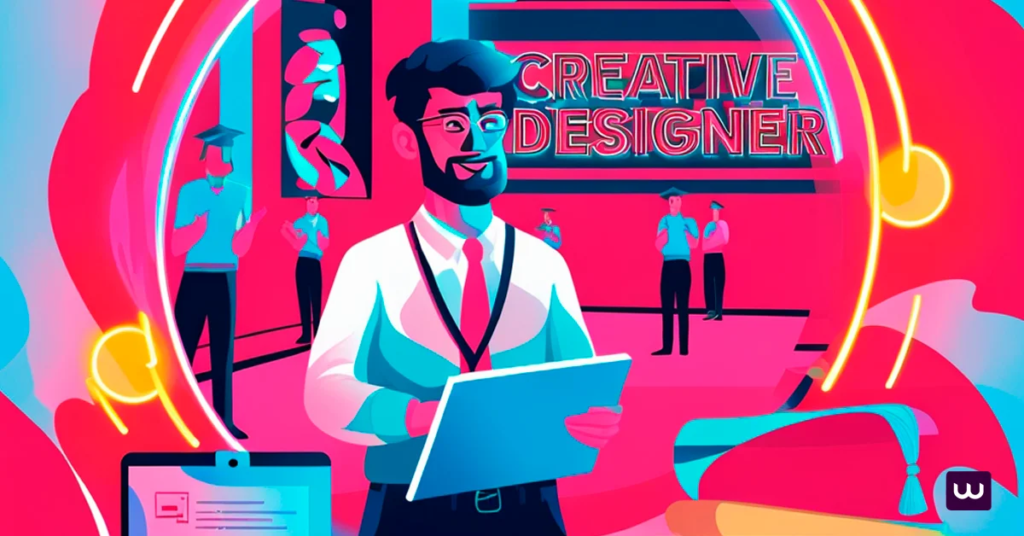
To embark on a career in UX design, it’s essential to first ascertain your passion for the field. Engage in thorough research and interact with established UX designers to solidify your decision. When you affirm that UX design is indeed your chosen direction, focus on gaining the requisite knowledge and abilities.
There are multiple educational avenues available for aspiring UX designers, including formal university degrees, online tutorials, and intensive bootcamps. Each of these options provides distinct advantages and equips you with a robust understanding of fundamental principles and methodologies within the realm of UX design.
Educational Paths and Courses
Individuals who aim to become UX designers can select from a variety of educational paths. Courses offered by degree programs in Human-Computer Interaction, Human-Centered Computing, Interaction Design, and Information Architecture deliver an extensive grasp of the principles that underpin UX design. These educational experiences typically incorporate practical projects and present opportunities for forming professional connections.
Alternatively, those seeking a more adaptable or swift approach may find superb foundational courses on online platforms such as Coursera and Accenture Digital Skills. Digital bootcamps like the Product Design program at Flatiron School offer intensive curricula which can be completed within several weeks to half a year, rapidly preparing students with skills ready for employment in the field.
Building a Strong Portfolio
A strong portfolio showcases your UX design capabilities and attracts employers. A good course offers fundamentals, hands-on tool experience, projects, and networking opportunities, demonstrating your skills and approach to challenges.
Tailoring your CV to highlight specific UX skills can enhance your job application and align it with your portfolio work. Your portfolio should tell the story of your design process, not just showcase the final designs. This narrative approach helps potential employers understand your problem-solving abilities and how you tackle design challenges.
Networking and Community Involvement
Advancing a career in UX design is significantly supported by networking, as it offers critical insights and business perspective and establishes essential connections. By interacting with fellow professionals, being present at sector-specific events, and contributing to discussions in forums, one stays abreast of current trends and industry standards.
In essence, participating actively in networking and community engagements elevates the possibilities for advancement and opportunity for a UX designer. This active engagement not only expands your expertise, but also paves the way for fresh prospects in your career path as well as potential collaborative ventures.
The Difference Between UX and UI Design

Grasping the distinction between UX and UI design is essential. While UX design is concerned with enhancing user experience by making products usable, enjoyable, and accessible, UI design pertains to the aesthetics of visual components such as screens and buttons, aiming to make them both visually appealing and user-friendly.
UX designers focus on functionality and ensuring overall user satisfaction, while UI designers dedicate their efforts to perfecting the visual aspects that support these experiences. The roles are fundamentally important in their own rights, but frequently collaborate intimately to forge designs that are unified in function and form.
UX vs. UI: Focus Areas
UX design primarily focuses on the user’s journey, enhancing usability and solving user problems. This involves tasks like user research, creating user personas, and mapping user flows. UX designers work to ensure that every interaction is smooth and meets user needs.
In contrast, UI design is limited to digital products and emphasizes the visual elements that users interact with, such as buttons, icons, and layouts. Some companies hire UX/UI designers to integrate both UX and UI practices, ensuring a seamless user experience that is both functional and visually appealing.
Collaboration Between UX and UI Designers
Close cooperation between UX and UI designers is essential for the success of any project, as they work together to align visual elements with a seamless user experience.
The main duty of a UI designer lies in crafting an intuitive user interface design that embodies the UX designs. This partnership guarantees that the end product not only functions effectively but also appeals visually, thereby improving navigation and simplifying interaction for the end user.
The Impact of Good UX Design

Effective UX design is crucial for the success of a business. It covers every aspect of an end-user’s engagement with the company, including its services and products. UX designers concentrate on crafting experiences that are both enjoyable and easy to use, thus addressing real-world problems and enhancing everyday products.
Good UX design has repercussions that reach beyond just individual users. It benefits businesses too. Firms investing in user experience see marked enhancements in user satisfaction levels as well as increased engagement, ultimately contributing to their commercial prosperity.
Enhancing User Satisfaction
By focusing on user needs and expectations, UX designers craft products that are functional as well as a pleasure to use. This not only fosters brand loyalty but also encourages repeat business by enhancing the overall user experience and customer satisfaction..
Implementing an effective UX design distinguishes a company by improving customer interactions, making them effortless and enjoyable, which in turn increases engagement with additional features. A flawless UX design can lead to increased sales by reducing usability problems that could otherwise repel customers.
Business Benefits of UX Design
Pouring resources into UX design yields a myriad of advantages. Firms that prioritize design enjoy a 41% increase in market share and boast a 46% edge over their competitors. Over ten years, businesses with a strong emphasis on design have surpassed the S&P Index by an impressive 219%, underscoring the tactical importance of exceptional UX.
Ensuring stellar user experiences is pivotal for customer contentment and cultivating brand devotion. By centering on UX, corporations can slash support expenditures through minimizing consumer aggravation and mishaps while upgraded interfaces contribute to boosting staff efficiency.
Allocating funds to enhance UX design translates into substantial corporate gains, encompassing heightened conversion metrics and superior customer continuity.
Summary of What is UX Designer
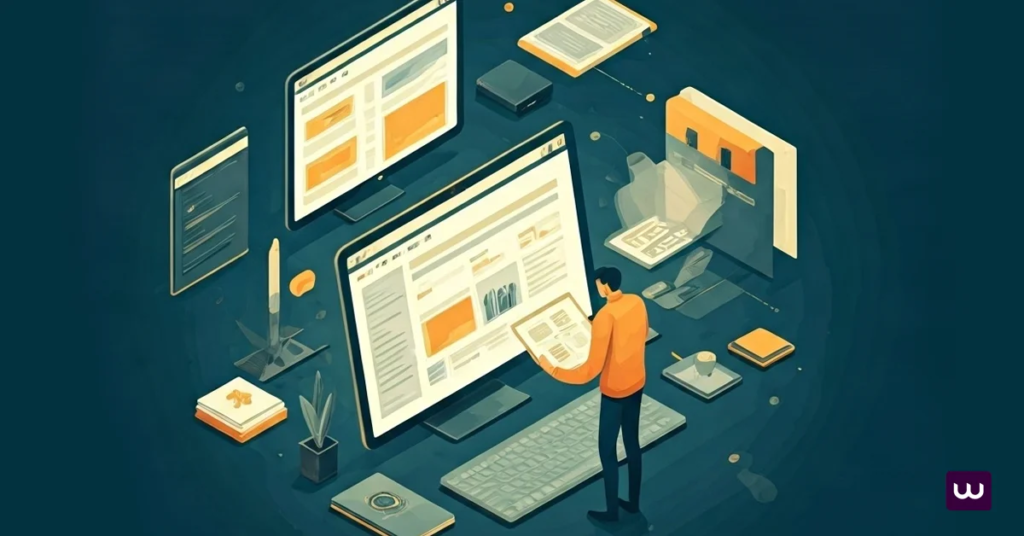
In summary, UX design is a multifaceted and dynamic field that plays a crucial role in creating user-centered products and services. From understanding the role of visual designer in a UX designer and the skills required to exploring the UX design process and career opportunities, this guide has covered all the essential aspects of UX design.
Good UX design can significantly enhance user satisfaction and offer substantial business benefits. By investing in UX design, companies can differentiate themselves from competitors, improve customer loyalty, and achieve greater success. Whether you’re just starting or looking to advance your career, the world of UX design offers endless possibilities and opportunities for growth and innovation.
Frequently Asked Questions
What is the primary role of a UX designer?
The primary role of a UX designer is to ensure that products are both enjoyable and accessible by deeply understanding user needs and crafting functional experiences. This involves creating interactions that are not only delightful but also intuitive, ensuring that users have a positive and seamless experience with the product or service.
What skills are essential for a UX designer?
To excel as a UX designer, it’s essential to master key skills such as user research, interaction design, and usability testing. These competencies form the foundation of creating user-centered products and ensure that designs align with user needs and expectations. Strong analytical thinking is crucial, allowing you to interpret data effectively and make informed design decisions.
In addition, honing your communication skills is vital, as it enables you to articulate design ideas clearly and collaborate efficiently with team members and stakeholders. Equipped with these skills, you’ll be well-prepared to create products and designs that truly resonate with users. By understanding user behaviors and motivations, you can craft experiences that are not only functional but also engaging and intuitive.
This approach ensures that users have positive interactions with the product, ultimately leading to higher satisfaction and loyalty. As a UX designer, your ability to blend technical expertise with empathy and creativity will be key to delivering exceptional user experiences.
How can I get started in UX design?
Embark on your UX design journey by immersing yourself in research, enrolling in courses or bootcamps, and crafting a strong portfolio. Building connections with professionals in the field can also pave the way for exciting career opportunities.
What is the difference between UX and UI design?
UX design and UI design serve distinct yet complementary purposes. UX design is centered around enhancing the overall user experience, ensuring that products are not only accessible but also enjoyable for users. It focuses on understanding user needs and crafting interactions that are intuitive and satisfying, ultimately leading to a seamless user journey.
On the other hand, UI design deals with the visual aesthetics and usability of the interface. It emphasizes creating visually appealing and easy-to-navigate interfaces that support the user experience. By combining the strengths of both UX and UI design, products can achieve a harmonious balance of functionality and visual appeal, resulting in truly delightful user experiences.
How does good UX design benefit businesses?
Investing in exceptional UX design fosters a thriving business environment by enhancing customer satisfaction and loyalty. When users feel valued and connected through seamless interactions, they are more likely to engage with the brand, leading to increased customer retention and positive word-of-mouth referrals.
Moreover, a well-designed user experience can streamline processes, reduce support costs, and boost employee efficiency by minimizing user frustrations and errors. This strategic focus on UX not only differentiates a company from its competitors but also drives long-term success and growth by aligning business goals with user needs.




